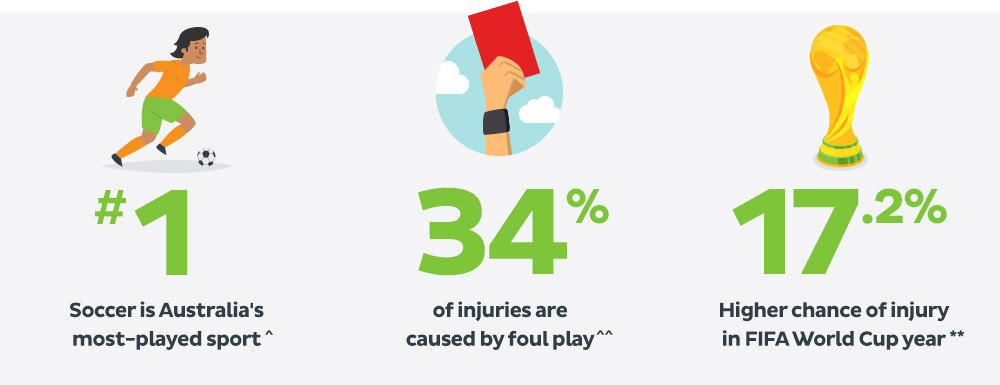How to avoid common football injuries
Health & Wellbeing -
Every four years the FIFA World Cup inspires casual viewers and fanatics alike to leap from their armchairs, dust off their boots and take to the field.
It's hard not to get swept up in the excitement and passion of the 'world game'.
The 'trickle-down effect' is a term used to describe how major sporting events – like the FIFA 2018 Russia World Cup – inspire a boost in grassroots participation.
An unfortunate corollary, however, is a spike in football injuries in World Cup years, according to this Canadian journal article analysing emergency department admissions.
So before you go rushing to the field, here are some pointers from the Socceroos’ team doctor and Head of Medical Services at Football Federation Australia, Dr Mark Jones.
Common football injuries
Not surprisingly, the most common football injuries are lower limb injuries.
“For example, hamstring strain from sprinting or overreaching,” says Dr Jones, who spoke to TAL from Russia where he's been busy preparing the likes of Australia's all-time leading goal scorer, Tim Cahill.

“Knee ligamentous injuries are also common – ACL or medial ligament injuries can be from contact, or from non-contact such as when landing from a jump or pivoting.
“Ankle sprains often arise as a result of contact in tackles.”
Moving up the body, groin, pelvic and lower back injuries can be triggered by overuse from twisting or turning, kicking and sprinting, Dr Jones says.
Avoiding common injuries
Dr Jones has the following recommendations for avoiding each of the most common football injuries.
- Hamstrings: Undertake hamstring strengthening and stretching programs.
- Knees: Work on quad and gluteal strengthening. Complete the FIFA Medical Centre of Excellence's warm-up program, FIFA 11+.
“FIFA 11+ has been shown to cause significant decrease in ACL injuries,” says Dr Jones.
“Research consistently shows a 30-50% decrease in general injury incidence if performed three times per week as a warm-up.”
- Ankles: Ensure ankle strength, flexibility and balance is incorporated into your exercise program.
“You can also have your ankles taped for training and matches,” Dr Jones says.
- Groin/pelvis/low back: Core stability and gluteal strengthening should be part of your exercise program. Be sure to stretch in order to improve flexibility.
Before the whistle
When the FIFA World Cup ad break comes on TV, and you're considering texting your mates to revive the old team, head over to TAL's Cover Builder and find a policy that suits you.
That way you’ll be covered for tennis too, when Wimbledon rolls around in July.
How much will Income Protection cost?
Get a quote
^ https://www.clearinghouseforsport.gov.au/research/smi/ausplay/results/sport
^^ https://sma.org.au/resources-advice/sport-fact-sheets/football-soccer-fact-sheet/
** https://onlinelibrary.wiley.com/doi/pdf/10.1111/jpc.13784
THE INFORMATION PROVIDED ON THIS WEBSITE IS GENERAL ADVICE ONLY AND DOES NOT TAKE INTO ACCOUNT YOUR INDIVIDUAL NEEDS, OBJECTIVES OR FINANCIAL SITUATION. YOU SHOULD READ THE RELEVANT PRODUCT DISCLOSURE STATEMENT (PDS) AND FINANCIAL SERVICES GUIDE (FSG) BEFORE MAKING A DECISION TO PURCHASE OR CONTINUE TO HOLD A PRODUCT. LIFE INSURANCE ISSUED BY TAL LIFE LIMITED ABN 70 050 109 450 AFSL 237848.
